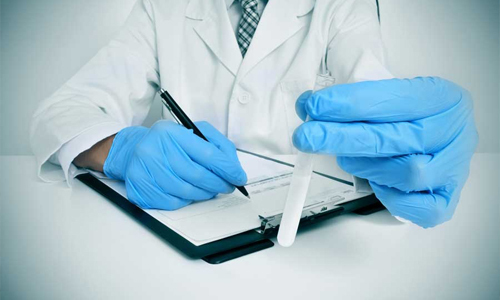pathospermia Modern men often suffer from various disorders in the process of producing semen. Poor quality of sperm can be due to insufficient activity of spermatozoa or their small amount, small volumes of sperm or its viscosity, etc. All these deviations are mainly associated with impaired spermatogenesis. In such clinical cases, a man is diagnosed with a pathospermia, which is often accompanied by infertility.

Warning! The bulk of clinical cases of pathospermia are not incurable forms, therefore, one should not treat such deviations as to the verdict. Modern andrology has a lot of highly effective techniques that will help get rid of infertility.
Fertility of a man and its relation to the pathospermia of
The reproductive health of a modern man is by no means very high. Unfortunately, the responsibility for the childlessness of a married couple is increasingly placed on men, as the quality of their fertility( the ability to fertilize) is steadily falling. Problems usually arise against the background of diseases of the reproductive system, which includes such organs:
- Sexual penis;
- Scrotum;
- Testicles;
- Testicles;
- Seminal vesicle;
- Seed cord;
- The vas deferens;
- Bladder;
- Prostate;
- Urinary canal.
Any pathology of at least one of these organs can negatively affect the process of sperm formation, which will affect the fertilizing ability of men. In general, fertility depends on many factors:
- Sperm volume;
- Number of active spermatozoa;
- Number of mature spermatozoa;
- Total number of spermatozoa, etc.
To determine these parameters, conduct a special laboratory study of the ejaculate - spermogram. In addition, experts assess the acid-base balance, viscosity, odor, consistency and color of seminal fluid. In addition, the composition of the sperm and the degree of spermatozoa agglutination( tackiness) are studied. As a result of the spermogram, various abnormalities and pathologies in the seminal fluid are revealed.
Important! In order for the results of the spermogram to be reliable, it is necessary to properly prepare for the analysis and fulfill a number of mandatory requirements.
Normally, an adult male with 1 ml of sperm has at least 20 million spermatozoa, at least half of the spermatozoa must move forward forcefully. Normal is considered when:
- Motor-active spermatozoa account for 70% of seminal fluid;
- The content of morphologically motile spermatozoa is at least half the volume of sperm;
- Live spermatozoa - 80%;
- Fixed sperm - 20%;Spermatozoa with weak mobility - 10%.
A healthy male in the seminal fluid lacks red blood cells and glued sperm, pH balance is about 7.2-7.8, and a single sperm volume of at least 2 ml. If any abnormalities are observed, then pathospermia is diagnosed.

Variety of disorders
Patospermia is classified according to the nature of the abnormality:
- Normozoospermia - is diagnosed when the diagnostic parameters of the sperm are normal, but there are some disorders that affect the fertilizing ability of the male;
- Oligozoospermia - when the percentage of sperm in the semen is significantly below normal;
- Hypospermia - when the volume of ejaculate is less than 2 mg;
- Azoospermia - is diagnosed in the case of complete absence of spermatozoa in seminal fluid;
- Necrosoospermia - characterized by the lack of live sperm in the ejaculate;
- Asthenozoospermia - spermatozoa with this deviation are characterized by insufficient mobility;
- Tetratozoospermia - diagnoses in cases where the ejaculate contains a large number of abnormal spermatozoa;
- Akinozoospermia - when all the sperm in the seminal fluid are immobile;
- Leukocytospermia - increased leukocyte count in semen;
- Hemospermia - when there are erythrocyte cells( bloody impurities) in the ejaculate;
- Viscosipathy is a condition of increased viscosity of the ejaculate, in which spermatozoa are more difficult to move in seminal fluid, so their motor activity decreases;
- The presence of mucus - normally sperm should not contain such components, the presence of mucus usually indicates the development of an inflammatory process in the genitourinary or reproductive system.
In addition to these varieties, the pathospermia is subdivided into a pronounced and unexpressed form. The expressed pathospermia is diagnosed when the sperm in the ejaculate is less than 5 ml / ml, the number of normal spermatozoa is below 8% of the total volume of the seminal fluid, there is no sperm motility completely. The remaining clinical cases refer to non-expressed pathospermic forms.
Reasons for deflections
Violations of this kind occur in men for a variety of reasons. Unexpressed forms of pathology are more often caused by varicose veins on the testicle and the spermatic cord, addictions and nonspecific factors. For diagnosis and treatment, standard methods are used. The cause of the expressed forms of pathospermia is usually changes in the genetic or hormonal origin, so in this case the man needs a more extensive and detailed examination.
Common causes of pathospermic abnormalities are:
- Varicocele - varicose veins on testicles;
- Various injuries of external and internal genital organs;
- Acidification or stagnation of sperm, gluing of spermatozoa;
- Lack of stability in sexual life( irregularity, excessive abstinence, too frequent sexual intercourse);
- Pathologies transmitted through sexual contacts such as chlamydia, gonorrhea, syphilis, etc.;
- Disturbances of autoimmune origin;
- Harmful habits such as alcohol, tobacco or narcotic substances;
- Inflammatory processes in the genitourinary system( prostatitis, orchitis, urethritis, epididymitis, etc.);
- Sexual abnormalities such as decreased sexual desire or weakening of erection;
- Treatment with some drugs from the group of antibiotics or steroids, improper food( fast food, fatty foods, preservatives and semi-finished products);
- Dangerous infections transmitted during childhood( mumps, etc.);
- Hormonal disorders due to insufficient levels of androgen hormones;
- Consequences of radiation exposure.
How to detect the presence of pathospermia
There are no characteristic signs for disorders associated with pathospermia. Usually such deviations are found in cases where a couple can not conceive a child for a long time, and the woman has already undergone a test, which confirmed her complete fertility. Only in this situation a man agrees to a test, including spermogram.
In the process of diagnosing pathospermia spermogram must be performed twice with a two-week interval, and if both results differ greatly in data, a third spermogram is assigned.
It can be said that the sign of pathospermic abnormalities is the absence of pregnancy in a couple that does not use any contraceptive means. If the pathospermia is associated with hypo-spermia, then a man can notice this by a reduced volume of sperm.
Treatment options for
The fundamental goal of therapy is to improve the sperm count, to improve the quality of the semen, and if necessary, its quantity. Only after performing such tasks a man will be able to experience the joys of paternity.
That's interesting! According to statistical and research data, every year the life of a man takes away almost 3.5% of spermatozoa in the seminal fluid. In addition, the number of men suffering from impaired sperm quality is increasing yearly.
To begin with, it is necessary to ensure proper conditions for restoring a man's health:
- Get rid of addictions;
- Eliminate possible industrial hazards;
- Stop taking drugs that have a depressing effect on spermatogenesis( drugs, antidepressants, steroid and neuroleptics, etc.);
- Normalize the sexual mode;
- To avoid hypothermia;
- The right diet;
- Avoid stress and depressive conditions;
- Stabilize the hormonal background;
To lead an active life( sports, fitness, exercise therapy).
After all these points have been completed, it is necessary to start treating the pathology that triggered the onset of pathospermia. In the inflammatory or infectious origin of the disease, anti-inflammatory or antibacterial treatment is used. And only after the elimination of the etiologic factor and its consequences do they begin to stimulate spermatogenetic processes.
This stimulation involves taking vitamin preparations, medicines and physiotherapy procedures. A more specific treatment strategy depends on the type of pathospermia and its severity.



